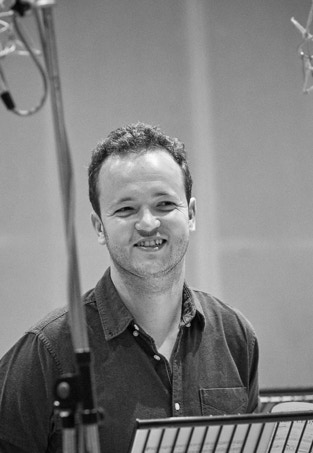Portrait of a Man
with a Sheet of Music
WITH
Claudio Monteverdi – Tempro la cetra (1619)
THE IMAGE
The informal nature of the portrait suggests that the sitter is an acquaintance of Leonardo’s at the Milanese court. Leonardo seems to have travelled to Milan from Florence with Atalante Migliorotti, a singer and instrument-maker. They were apparently sent as artistic emissaries from Lorenzo de’ Medici to Duke Ludovico Sforza. In a list of drawings, probably compiled in 1482 when he arrived in Milan, Leonardo mentions ‘a head portrayed from Atalante who raises his face’.
Giorgio Vasari in his Life of Leonardo (1550 and 1568) tells us that Leonardo took with him a novel ‘lyre’ in the shape of a horse’s skull. Whether or not this story is accurate, it is evident that Leonardo was skilled at improvising on the lira da braccia.
The painting is clearly incomplete. The head and hair have been brought to a full level of finish, but the sitter’s stole is no more than a rough underpainting. The quality of the more finished sections – the vortex hair with its scintillating highlights, the head with its emphatic bony structure, and the eye with its moist intelligence – endow the picture with the sense of living presence that is altogether characteristic of Leonardo.
MARTIN KEMP
———————————————————————————————————————
THE MUSIC
Migliorotti played the lead role in the important production of Poliziano’s Orfeo that the Mantuan court put on in the 1480s (some 120 years before Monteverdi’s L’Orfeo at the same court). The instrument associated with Orfeo was the lyre: both Leonardo and Migliorotti were masters of its Renaissance incarnation (the lira da braccio) and Monteverdi embodies its sound-world with five string instruments in this rapturous work.
ROBERT HOLLINGWORTH
lira da braccio

TEXT / TRANSLATION
Tempro la cetra e per cantar gli honori
di Marte, alzo tal hor lo stil e i carmi;
ma invan la tento, et impossibil parmi
ch’ella già mai risuoni altro ch’ amori.
Così, pur tra l’arene e pur tra fiori,
Note amorose Amor torna a dettarmi;
nè vol ch’io prend’ ancor a cantar d’armi,
se non di quelle ond’egli impiaga i cori.
Or l’humil plettro e i rozzi accenti indegni,
Musa, qual dianci accorda, infin ch’al canto
de la lira sublime il Ciel ti degni;
Riede ai teneri scherzi e dolce intanto
lo Dio guerrier, temprando i feri sdegni,
in grembo a Citherea dorma al tuo canto.
Giovan Battista Marino (1569-1625)
I tune my lyre, and to sing the honours
of Mars I thus uplift my style and songs;
but in vain I try, and it seems impossible
that it will ever resound with anything but love songs.
Thus, even in arenas and even amidst flowers,
Love returns to dictate amorous notes to me;
nor does he desire that I should sing again of weapons,
unless of those with which he wounds the heart.
The lowly plectrum and coarse undignified inflections,
O Muse, refine them as you did before, until, to the song
of the sublime lyre, Heaven honours you.
Now to sweet and tender play returns
the God of war, tempering his harsh anger;
may he sleep in the arms of Cytherea to your song.
I FAGIOLINI
Matthew Long & instrumental ensemble
Catherine Martin, Naomi Burrell – violin
Stefanie Heichelheim, Rachel Stott – viola
Peter McCarthy – bass violin
David Miller, Eligio Quinteiro – chitarrone
Catherine Pierron – harpsichord
Kirsty Whatley – harp

Matthew Long
Tenor
Credit Matthew Brodie